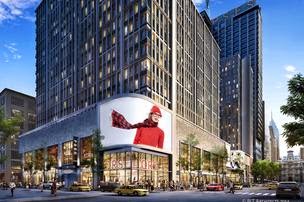On its own, Comcast Center redefined Philadelphia's notion of Center City skyscrapers. With the exception of its northern neighbor, the Bell Atlantic or Verizon tower, Philadelphia's humble portfolio of true skyscrapers hug their sidewalks. On one block that could have easily housed Comcast's entire vertical campus, the cable giant decided to create a spectacle. Using a could-be footprint for another tower, Comcast opted for a grand plaza that breaks up the towering monotony of JFK Boulevard by creating a vantage point from which to admire Robert A. M. Stern's local masterpiece.
In a lot of ways, the theory echoes Mies van der Rohe's Seagram Building in Midtown Manhattan. As height restrictions led New York developers to step their skyscrapers back from the sidewalk in an effort to maximize every square foot, Mies van der Rohe decided to make a statement by "wasting" land on a plaza and designing a completely vertical skyscraper.
Likewise, Comcast's plaza makes its Center both humbling and intimidating, and in providing both, likely achieved the company's goal. It's easy to wonder why the CITC isn't a bit taller. Why is the roof shorter than Comcast Center? Why does the spire face west, and not the campus's core? They may seem irrelevant questions, but no one spends $1B on a building without analyzing every last detail.
Were the CITC taller, if its spire faced Comcast's plaza, its presence might overpower Comcast's corporate headquarters. Despite its academic rank as Pennsylvania's tallest building, the CITC is still second to Comcast Center and its plaza.
As the sum total stands, Comcast's vertical campus will be Philadelphia's best planned corporate park, at least in the West Market vicinity. With the exception of Independence Hall, the University of Pennsylvania's historic core, and a handful of other 18th and 19th Century projects, Comcast has set a new bar for future development.
----------------
However, what works aesthetically may not prove so practical, and it all hinges on Comcast's true plan for the CITC. As it is, Comcast is a telecom corporation, with only a very new and relatively small investment in information technology. IT companies throughout the Silicone Valley, the Cascade Valley, and the Dulles Corridor are comprised of sprawling campuses that look like high-tech universities.
While many of these corporations decided to set up shop in the suburbs for financial reasons, the reasons they've stayed are logistic. It's not as though Apple, Microsoft, and Intel can't afford to build their own vertical campuses in San Francisco, Seattle, or Portland, it's that they don't want to. And for good reason.
 |
| Apple's upcoming Concordia campus |
Comcast, despite its apparent desire to delve into IT, is still every bit as corporate as JP Morgan. Although Big Software plays the corporate game on the same trading room floor, their philosophy, operations, and corporate demographics are at odds with Comcast's 52 year old model.
The free spirited software geeks tethered to their iPads and laptops aren't tethered to their cubicles. IT's endless string of meetings is less the end result of corporate bureaucracy, but a place for collaboration and productive innovation. The IT campus is very much a hive, not a hierarchy of elevator banks that reserve the uppermost floors for a select few.
It will be interesting to see not only how Comcast fares in the unfamiliar world of information technology, but also how its vertical campus manages to support it. If it works, the CITC and Philadelphia will change the industry's game, proving that software and innovation can accommodate fixie saddled Millennials unwilling to commute or relocate to the Silicone Valley or King of Prussia. But Comcast's foray into innovation needs to be more than a building, a concept, and a vertical theory. First and foremost it needs to understand innovation, why software empires succeed, and why so many more come and go overnight.
Information Technology is not an industry that survives on the status quo. It is the modern and global embodiment of the first 40 years of the automotive industry. It's a technological revolution that refuses to peak. Profitable Big Software doesn't succeed through mergers and acquisitions, those are simply the end results of successes and failures. Comcast can't buy its way into Information Technology, rather it needs to understand that companies like Apple and Google thrive by way of true innovation and a market that continues to crave the next best thing.





